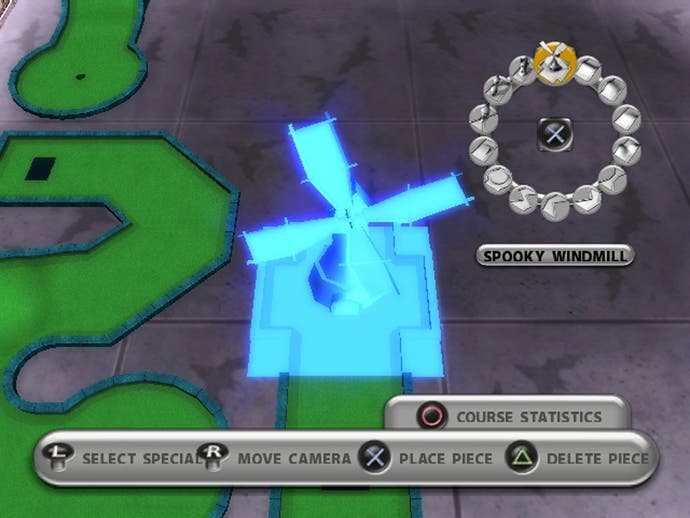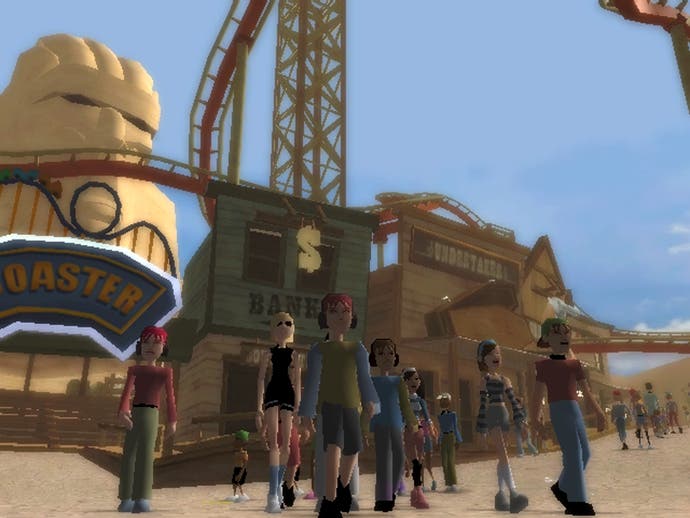Thrillville
All the fun of the fear.
It's not too difficult to understand why people like to ride rollercoasters. An illusion of danger is always addictive, as is the thrill of being thrown from axis to axis, brain sloshing as it bats away fight/flight conundrums from a spitting adrenal gland. Indeed, blurrily glimpsing your own high-speed death with nothing but a taut plastic harness and the promise of a flimsy hotdog bought from a man in a chicken suit on the ground for comfort, helps sharpen life's focus.
Likewise, it's not too difficult to understand why people like to design rollercoasters. We've all known the sadistic glee of burning ants with a magnifying glass and hot sun. Rollercoaster designers must be the same - albeit adults with architectural degrees and now the ants are holidaying children and the hot sun is steel girders, physics and fearsome 125kph maths.
But understanding people who design games that allow people to design rollercoasters for virtual people to ride on is getting beyond us. As, it turns out, are their games. Despite the easy-going origins in Bullfrog's Theme Park, the genre has lately become bound up in microscopic management of dry business stats, the balancing of virtual profit margins and keen demographic profiling rather than the innocent fun of burning children. Er... Ants. It's become a niche within a niche and so, it's a pleasant surprise to find this game from Frontier, the developer behind Rollercoaster Tycoon 3, is more concerned with the funfair candyfloss and mini-games than making you do an approximation of your real life job at home.
Nevertheless, the premise between the two games echoes clearly. Thrillville casts you as a theme park manager. The idea is that you administer the day-to-day running and capitalistic expansion of the park while the owner and eccentric inventor, your Uncle Mortimer (and Back to the Future Doc Brown's long lost twin) works away at R&D, conjuring ever more wonderful and terrifying experiences to fill the park with.

A brief tutorial explains the five main areas of gameplay: building rides, riding rides (in the form of playing mini-games), chatting to your visitors (to make friends and hear feedback), hiring, training and firing staff and managing the park's funds. If that seems more complicated than the introduction suggested, it's important to note that the game emphasises the riding of rides more than any other gameplay area - as evidenced by the fact it's possible to play the game in Party Mode without ever needing to run your eyes over a monotone expenses spreadsheet.
That's because, at its heart, Thrillville is a collection of mini-games cloaked in the trappings of a business management sim. In the single-player game these are each played by 'riding' a specific ride - the more attractions you create the more games are unlocked. These mini-games range in style and execution but each draws on videogaming's stock genres for its heavily evidenced inspiration. There are Bishi-Bashi style arcade vignettes, a Flicky platform rip-off, a Wipeout-lite racing game and a rudimentary, but brilliantly enjoyable, robot-based FPS. What characterises the mini-games (apart form their shoehorned funfair-style themes) is their general high quality: each game displaying complexity, width and depth that deftly counters expectations.
Of course, each mini-title is shamelessly derivative - Thrillville's in-game arcade the worst offender, being populated with a raft of instantly recognisable arcade copies. In the single player mode your performance at each mini-game is ranked out of five stars and, depending on how well you did, you earn money to spend on other things in the park. Specific challenges using the mini-games are also set by the game (e.g. beat a park visitor's high score on X game) and this gameplay framework is at once straightforward and effective.

There are five parks in the game and, as initially only one is open to you, you must complete a percentage of the twenty-five missions per park to unlock the next. Each mission is scored Bronze to Gold and varies in scope and theme from building drinks machines to satiate thirsty customers to training your entertainment staff by participating in a simple Gitaroo-Man style rhythm action game.
The weakest of the Mission categories is 'Guest missions' which have you approaching park visitors to talk trivia with them. The idea is that by selecting an appropriate subject to talk about with a particular guest, you can fill a 'friendship' meter and win them over to be loyal consumers. The topics of conversation are initially interesting enough but it quickly transpires that hammering the X-button to race through as many topics of conversation as you can will make you best buddies quicker than anything else - something which both eases and neuters the weaker design of this section of the game.
Graphically Thrillville is dated, demonstrating the simple character models, shoddy textures and rudimentary animations that can sometimes characterise games simultaneously developed for the PS2 and PSP. That said, there's a good deal of character within what was clearly a tight budget with the graphic design - especially at the front end of some of the mini-games - bright, fun and interesting. Also the soundtrack, which sets licensed (and unlikely) artists such as K T Tunstall alongside some bespoke, more videogame-style American techno, is surprising and mostly welcome.
It would be easy to dismiss this as Rollercoaster Tycoon: Kid's edition - certainly the superficiality of the statistical balancing and ride designs suggests that to be the case. But, in actuality, Thrillville is straining so hard at the genre boundaries of management sims that it tips generously into party game territory - something that the variety of mini-games on offer emphasises. But audacity with genre is only sometimes synonymous with quality and, on this count, the game is less successful. Where Thrillville shines it does so because it cribs from the videogaming canon's great high points - no mean feat to do so in such quantities displayed here but still, no great achievement either. On a rainy day there's an enjoyable few hours to be had riding these highs. On a sunny day, a trip to the theme park and riding a rollercoaster would be more understandable.

